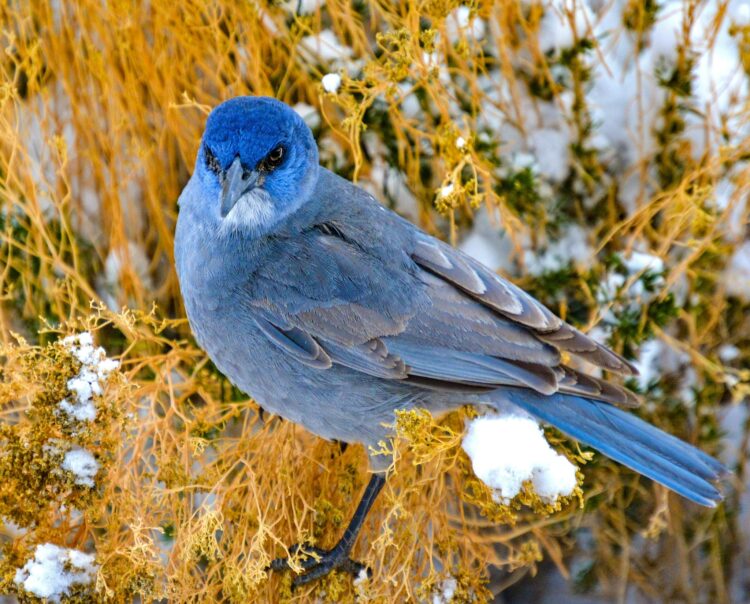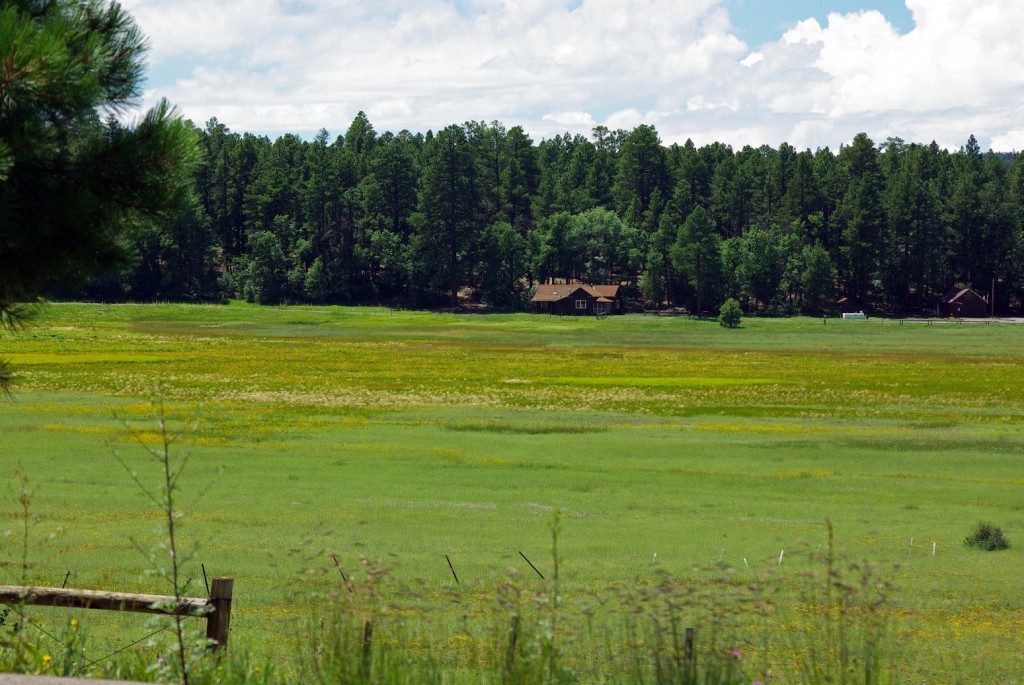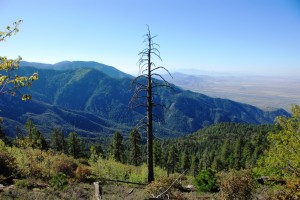Conservation Stewards: Northern Arizona Audubon Society and Arizona Antelope Foundation
Size: 261 square miles, 167509 acres
Identified: 01/2004. Global: 10/2009
Visiting the IBA: Located 20 miles southeast of Flagstaff, take the Lake Mary Road exit and travel east on Forest Road 3. Mormon Lake Lodge is located on the south side of Mormon Lake. There are overlooks, trails and two-track roads throughout. Anderson Mesa Station – Arizona Birding Trail, Ashurst Lake – Arizona Birding Trail, Marshall Lake – Arizona Birding Trail, Mormon Lake – Arizona Birding Trail
Ownership: Coconino National Forest and private landowners.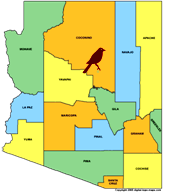
Site Description: Anderson Mesa begins about 9 miles southeast of Flagstaff and is a gently sloping tableland for approximately 25 miles to the southeast. The northern lakes are Marshall, Lower and Upper Lakes Mary, and Mormon. Ashurst and Kinnikinck Lakes are more central. The southern lakes are Long, Soldiers’, Soldiers’ Annex, Tremaine and Hay. Along the length of the mesa are many ephemeral wetlands of varying sizes. Low bluffs outline part of the western edge and Lakes Mary & Mormon are below the bluffs. Various habitats are coniferous & deciduous trees, shrubs, small canyons, open grasslands, seasonal marsh wetlands, and shallow wet meadows. The central portion of mesa is made up of plains grasslands, habitat for Pronghorn Antelope herds.
Birds: Species of special conservation status and interest that use the habitats within this IBA include:
Breeding: The pinyon and juniper woodlands provide significant habitat for Pinyon Jay, and the IBA has global recognition for this species. Also breeding there are Cinnamon Teal, Band-tailed Pigeon, Virginia Rail, Sora, Osprey, Pied-billed Grebe, Western Grebe, Clark’s Grebe, Purple Martin, Virginia’s Warbler, Red-faced Warbler.
Migration: Ruddy Duck, Gadwall, American Wigeon, Mallard, Blue-winged Teal, Cinnamon Teal, Northern Shoveler, Northern Pintail, Green-winged Teal, Redhead, Ring-necked Duck, Bufflehead, American Avocet, Bald Eagle, Peregrine Falcon, White-faced Ibis and American White Pelican.
Conservation Concerns: Grassland and wetlands habitat health requires management of grazing, off highway vehicle travel and fire. Loss of the grasslands impacts the Pronghorn Antelope population and the grassland bird assemblage (primarily horned larks, sparrows, and meadowlarks). Immediate concerns are: drought, fire, and grazing in wetlands by livestock and wildlife. Strategies: off-highway vehicle management, exclusion of livestock and elk from wetland areas, replanting wetland species, and fire management through prescription fires.
Maps of this Important Bird Area:

Arizona Game and Fish Department Conservation Opportunity Area
Complete eBird.org Checklist of birds Reported for Anderson Mesa IBA
For an interactive map and habitat and land ownership analysis of this IBA visit the National Audubon IBA Map and select “Arizona” and then select this IBA
Location: 35.017° N: 111.400° W
County: Coconino
Site Status: Identified 01/2004, Global Identified 10/2009
Ownership: Coconino National Forest
Area: 261 square miles, 167509 acres
Criteria: Global: Species of Conservation Concern (Pinyon Jay)
State: Waterfowl and Species of Conservation Concern (Bald Eagle, Osprey, Clark’s Grebe, American Avocet, White-faced Ibis)
Vegetation Communities:
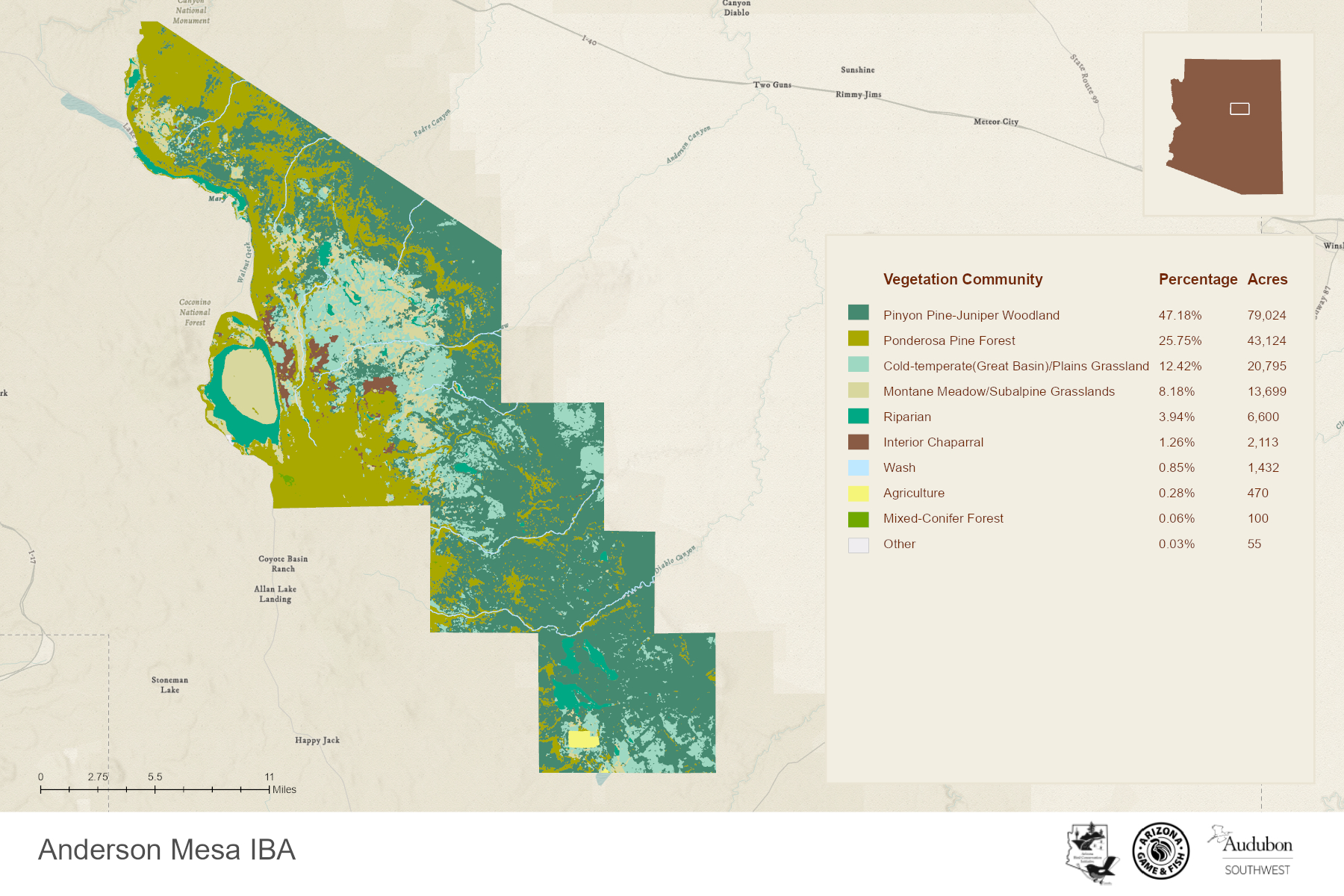
| Vegetation Community | Acres |
| Pinyon Pine-Juniper Woodland | 79,024 |
| Ponderosa Pine Forest | 43,124 |
| Cold-temperate (Great Basin) Grasslands | 20,795 |
| Montane Meadow-Subalpine Grassland | 13,699 |
| Riparian, Emergent Wetland, and Open Water | 6,600 |
| Interior Chaparral | 2,113 |
| Wash | 1,432 |
| Agriculture | 470 |
| Mixed Conifer Forest and Woodland | 100 |
| Other: Rock, Residential, Open-pit Mine | 55 |
This area is a lake complex that also includes permanent, semi-permanent lakes and wetlands, ephemeral wetlands, grasslands, pinyon-juniper and coniferous forests. Northern Arizona Audubon Society is the steward for this site. More information about Northern Arizona Audubon Society and how you can help as a volunteer can be found at Northern Arizona Audubon Society
This site has been documented as one of two major waterfowl use areas in Arizona during migration, particularly by dabbling ducks during spring migration. Over 2000 waterfowl were documented using this area during spring migration in the early 1990s. Although severe drought has reduced the numbers of breeding birds, this site remains a significant migration stop over for waterfowl, water birds, and wading birds during years when sufficient moisture occurs during the winter. A goodly variety of land birds also use this area as a migration/breeding area. The “Checklist of the Birds of Mormon Lake Arizona & nearby areas (Lakes Mary & Ashurst, Anderson Mesa)” contains 230 species, approximately 45% of the official list for birds noted to occur in Arizona. In addition to providing habitat for migrating and breeding birds, these permanent, semi-permanent lake waters and ephemeral wetlands attract many vagrant bird species as well. The natural wetland system within this IBA provides excellent habitat for migration, and on-going restoration and protection of this wetland complex will further enhance the value of this area to nesting waterfowl and wetland birds. The restoration work by the Arizona Game/Fish at the Long Lake Complex and at Hay Lake has enhanced the natural retention of snow and rain precipitation over 1200 acres. From a landscape perspective, the Anderson Mesa, contains the only major wetland complex between Lake Roosevelt to the south and Lake Powell to the north.
Conservation Issues: Drought is the highest threat. Control of grazing by cattle and elk is essential. To mitigate the impacts to the wetlands from grazing and prolonged drought the U.S. Forest Service has implemented an innovative management strategy that protects the wetlands by regulating the times and duration of grazing in permitted areas. Wetlands are being protected from livestock by constructing fences that still allow passage of wildlife. Other threats include, fire, invasive plants, commercial timber harvest projects, disturbance to birds, certain recreation activities, and water transfer through surface water abstraction. Habitat restoration, including the restoration of grasslands is in progress. The ranchers are actively engaged through the Diablo Trust and numerous conservation organizations have assisted in achieving conservation objectives for this site.

